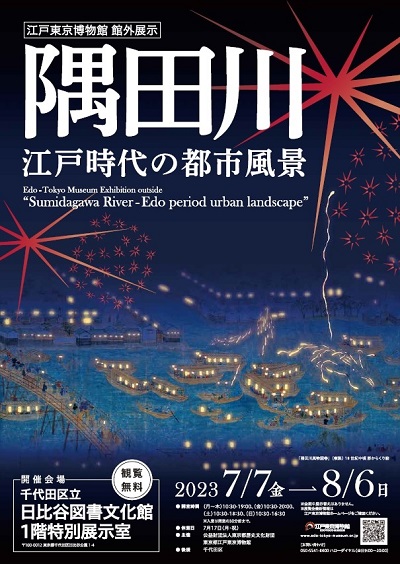2023.07.07(Fri)〜2023.08.06(Sun)


2023.07.07(Fri)〜2023.08.06(Sun)


The Edo-Tokyo Museum has closed for an extended period of time beginning April 1, 2022, for large-scale renovations. As one of the projects during the closure, we jointly held the international exchange exhibition “Scenes Around Sumida River in Edo Tokyo” with the Seoul Museum of History, which has been collaborating with our museum for many years. The exhibition was well-received. This exhibition is meant to summarize the exhibitions above in a succinct manner, and give a more careful look at what makes them special. The Sumida River, which was a major transportation artery for the people of Edo and a well-loved scenic spot, will be showcased through pieces from the museum’s collection. In addition, among the precious cultural properties of Chiyoda Ward, which will host this exhibition, works by Utagawa Hiroshige (2nd generation) and Utagawa Toyokuni (3rd generation) from the Kinokuniya Mitani family collection will also be exhibited. Please take this opportunity to enjoy the colorful world of the Sumida River, one of the symbols of the city of Edo.
| Period | Friday, July 7 to Sunday, August 6, 2023 | |||||||||||||||
|---|---|---|---|---|---|---|---|---|---|---|---|---|---|---|---|---|
| Venue | Chiyoda Ward Hibiya Library & Museum 1st Floor Special Exhibition Room 1-4 Hibiya Park, Chiyoda-ku, Tokyo ・About 3 minutes on foot from Tokyo Metro Marunouchi Line/Hibiya Line, Kasumigaseki Station, Exit B2 ・About 3 minutes on foot from Toei Subway Mita Line, Uchisaiwaicho Station, Exit A7 ・About 3 minutes on foot from Tokyo Metro Chiyoda Line, Kasumigaseki Station, Exit C4 ・About 10 minutes on foot from JR Shimbashi Station, Hibiya Exit ※There are no car or bicycle parking lots. Please use public transportation. |
|||||||||||||||
| Hours |
|
|||||||||||||||
| Closed | Monday, July 17, 2023 There will be no changes to the exhibition during the exhibition period. |
|||||||||||||||
| Organized by | Tokyo Metropolitan Edo-Tokyo Museum operated by Tokyo Metropolitan Foundation for History and Culture | |||||||||||||||
| Supported by | Chiyoda Ward | |||||||||||||||
| Admission | Free | |||||||||||||||
| Contact | 050-5541-8600 (9:00~20:00) |
Prologue: A Story of the Sumida River
The Sumida River flows through the eastern part of Tokyo and into Tokyo Bay. It was known by various other names depending on the location. For example, downstream of the Senju Ohashi Bridge it was called the Sumida River, but around Asakusa it was called either the Asakusa River or the Miyato River. In the vicinity of Ryogoku, it was called the Ryogoku River, and further downstream, the Okawa River. In this way, the Sumida River, which was the largest river in the city of Edo, was a major transportation artery for the people of Edo. At the same time, the river itself was beloved as a scenic spot in Edo, and its banks offered many fabulous views of the city. In the prologue, we first introduce three stories related to the Sumida River.
Chapter 1: Gazing at the Sumida River
In the Edo period, when there were no tall buildings, you could see Mt. Fuji and Mt. Tsukuba in the distance, and the famous shrines and temples along the river bank in the foreground when looking out from a bridge or boat. The paintings depicting the Sumida River in expansive spaces are not only beautiful in themselves, but are also valuable because they depict well-known sights that were and are deeply intertwined with people’s lives.
Chapter 2: Sumida River’s Traditions
The people of Edo paid close attention to the changing of the four seasons, and enjoyed seasonal events throughout the year, such as cherry blossom viewing in spring, cool boat rides in summer, moon viewing in autumn, autumn leaf viewing, and snow viewing in winter. They also enjoyed outings for annual events such as festivals at temples and shrines, including Hinamatsuri (Doll’s Festival), and Tanabata (Star Festival). You can also see examples of season-inspired works at famous places around the Sumida River.
This chapter presents paintings depicting various famous places along the Sumida River that incorporate seasons.
Epilogue: The Sumida River in the City of Tokyo―From Edo to Tokyo
When the Edo Shogunate came to an end and the era changed to Meiji, the Sumida River underwent a major transformation. In the wake of the Great Kanto Earthquake of 1923 (Taisho 12) and subsequent modern urban reconstruction plans, numerous bridges called “restoration bridges” were successively built over the Sumida River, and the appearance of the Sumida River itself changed greatly. To this day, the modern, attractive appearance of these “restoration bridges” over the Sumida River cannot be overlooked when talking about the beauty of the scenery of Tokyo.
